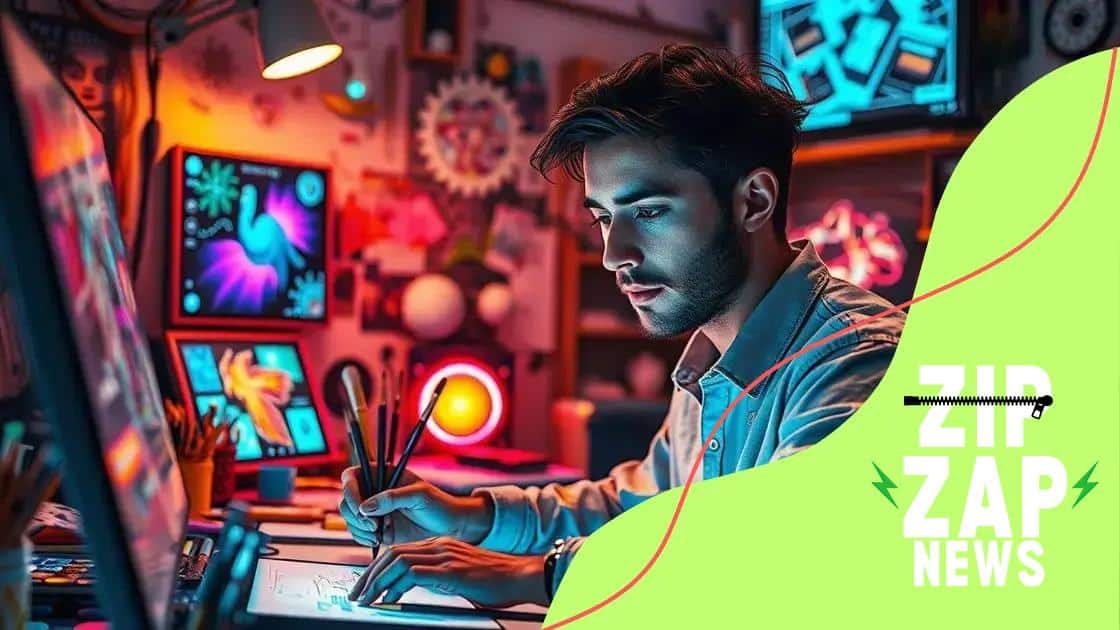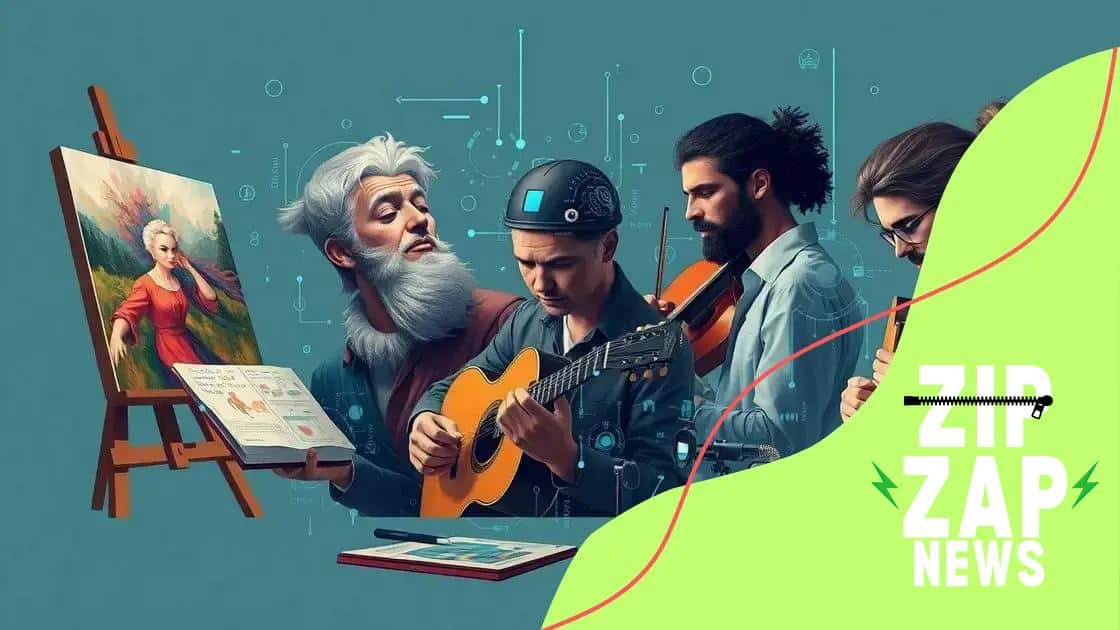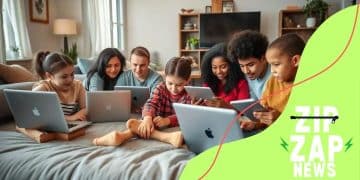The role of AI in transforming the creative industries

The role of AI in transforming the creative industries includes enhancing artistic expression, enabling personalized experiences, fostering collaboration, and addressing challenges related to originality and authorship.
The role of AI in transforming the creative industries is becoming increasingly significant. Imagine how artists and creators leverage AI tools to unlock new levels of creativity and efficiency. What potential lies in this intersection of technology and artistry?
Understanding AI in the creative sectors
Understanding AI in the creative sectors opens up a fascinating discussion about how technology enhances creativity. As artificial intelligence evolves, it plays a pivotal role in reshaping how artists, designers, and creators express themselves and produce work.
What is AI?
AI refers to computer systems designed to perform tasks that typically require human intelligence. These can include problem-solving, speech recognition, and, importantly, creative processes.
Benefits of AI in Creativity
AI brings numerous advantages to the creative sectors:
- Enhanced Efficiency: AI tools can automate repetitive tasks, allowing creators to focus more on their artistic vision.
- New Possibilities: Technologies like generative algorithms can create unique artwork, expanding the limits of what is possible.
- Personalization: AI can analyze preferences, leading to tailored creative outputs that resonate more with audiences.
- Collaboration Tools: Innovative platforms enable creators to collaborate in real-time, no matter where they are.
In addition to these benefits, the relationship between AI and creativity raises intriguing questions. How does an artist’s input shape the output generated by AI? The answer to this connects directly with the essence of creativity itself.
Many creators are now using AI as a partner in their work. For instance, in music, software can suggest melodies and harmonies based on a few notes. In visual arts, algorithms can analyze thousands of artworks to inspire new styles or techniques. This blending of technology and traditional methods leads to innovative creations that challenge conventional boundaries.
Artists today enjoy an expanded toolkit, supported by AI. With its ability to analyze trends and provide insights, AI not only acts as a collaborator but also as a tool that can drive inspiration. It is indeed exciting to see how the creative sectors continue to evolve with this powerful ally.
How AI enhances artistic expression
How AI enhances artistic expression is a vital topic that explores the intersection of technology and creativity. Many artists are discovering that artificial intelligence acts as a powerful tool that can enhance their creative processes.
Transforming Traditional Art Forms
AI is reshaping traditional art forms by introducing new methods of creation. Artists can now use algorithms to generate patterns or create entirely new styles. This blending of technology and tradition allows for the emergence of innovative artistic expressions.
Interactive Art Experiences
With AI, artists can create interactive experiences that engage audiences in new ways:
- Responsive Installations: Some installations react to viewer movements, altering visual displays in real-time.
- Generative Art: Algorithms produce unique pieces that change each time they are viewed, making art feel alive.
- Collaborative Tools: Platforms allow artists to combine their skills with AI capabilities, leading to creative partnerships.
- Emotion Recognition: AI can analyze audience reactions, helping artists tailor their work to better connect emotionally.
These advancements not only diversify artistic expression but also invite new discussions about authorship and creativity. Is the artist still the sole creator when AI contributes significantly? This question shifts our understanding of the creative process itself.
Many musicians use AI to compose music, generating melodies based on learned patterns. This offers artists inspiration while still allowing for their personal touch. For instance, when lyrics are combined with AI-generated sounds, a new genre of music can emerge, showcasing the beauty of collaborative creation.
In visual arts, AI tools can take inspiration from existing art to create something new, introducing styles and techniques that artists might not have considered. This collaborative approach encourages a richer exploration of artistic possibilities and leads to works that challenge conventional norms.
Real-world applications of AI in creative fields

Real-world applications of AI in creative fields showcase the incredible potential of technology to enhance creativity and innovation. Artists and creators across various disciplines are beginning to incorporate artificial intelligence into their work, leading to groundbreaking results.
AI in Visual Arts
In the realm of visual arts, artists use AI to create stunning and unique pieces. AI algorithms analyze existing artworks to inspire new designs and techniques. This results in:
- Generative Art: Artists create visuals that change continuously based on data input, producing an ever-evolving piece.
- Style Transfer: This technique allows artists to apply the visual style of one image to another, blending different styles seamlessly.
- Augmented Reality: AI enhances traditional art by enabling interactive experiences that engage viewers in real-time.
Many galleries now feature digital installations that use AI to respond to visitors, creating a dynamic experience. These technologies not only attract audiences but also invite deeper engagement with art.
AI in Music Production
In the music industry, AI is transforming how musicians create and produce their work. Artists can utilize AI-driven software to:
- Generate Melodies: Compositional tools suggest tunes based on selected styles or themes, sparking inspiration.
- Master Tracks: Advanced algorithms assist in mixing and mastering tracks, improving sound quality.
- Analyze Trends: AI can assess listener preferences, guiding artists on what resonates with their audience and shaping future projects.
This technology allows musicians to explore new sounds and styles while maintaining their unique identity. Working alongside AI can lead to innovative tracks that might not have been conceived without this collaboration.
In literature, AI assists authors by providing suggestions for plot development or character arcs, helping to overcome writer’s block. Tools analyze existing literature, offering insights and recommendations that enrich storytelling experiences.
These applications highlight the versatility of AI across creative fields. Artists and creators can embrace this technology to enhance their skills, producing exceptional work that reflects both human and machine collaboration.
The benefits and challenges of AI for creators
The benefits and challenges of AI for creators is an important discussion as artists and innovators navigate the evolving landscape of technology. While artificial intelligence offers many advantages, it also presents challenges that creators must address.
Benefits of AI for Creators
AI provides several benefits that can enhance the creative process. These advantages include:
- Increased Efficiency: AI tools can automate repetitive tasks, enabling creators to focus on more important aspects of their work.
- Enhanced Creativity: By suggesting new ideas or styles, AI can inspire artists to explore different creative avenues.
- Personalization: AI can analyze audience preferences, helping artists tailor their work to meet specific demands.
- Collaboration: Artists can collaborate with AI systems to expand their creative capabilities, blending human intuition with machine learning.
These benefits lead to a more dynamic and innovative creative environment, allowing artists to push boundaries and experiment with new forms of expression.
Challenges Faced by Creators
Despite the advantages, using AI also poses certain challenges. Some of these challenges include:
- Loss of Originality: Relying too heavily on AI tools may lead to art that feels formulaic or lacks personal touch.
- Understanding Technology: Many artists may struggle to learn and integrate AI tools into their existing workflows.
- Ethical Concerns: Questions arise about authorship and ownership when AI contributes significantly to creative works.
- Dependence on Data: AI relies on large datasets to function, and biases in those datasets can impact the final creative output.
Addressing these challenges is crucial for creators who wish to thrive in an AI-enhanced world. It is essential to strike a balance between leveraging technology and maintaining personal artistic integrity.
Ultimately, the relationship between creators and AI is complex and multifaceted. By embracing the benefits while being mindful of the challenges, artists can navigate this landscape successfully. The ongoing dialogue around AI’s role in creativity will shape how art evolves in the future.
Future trends of AI in the creative industries
Future trends of AI in the creative industries are exciting to consider as technology continues to advance. As artificial intelligence becomes more integrated, it will reshape how creators work and express themselves.
Personalization through AI
One significant trend is the increasing use of AI for personalization. Creators will rely on AI algorithms to tailor their work to specific audiences. This capacity will allow artists to:
- Analyze Audience Behavior: AI can examine how audiences engage with art and music, shaping the creative process accordingly.
- Create Custom Experiences: Artists might produce unique works for individual viewers, making art feel more intimate and relatable.
- Predict Trends: By analyzing current cultural trends, AI can help artists anticipate what styles or themes will resonate in the future.
This trend towards personalization will not only enhance audience engagement but also foster deeper connections between creators and their fans.
AI-Enhanced Collaboration
Another important trend is the rise of AI-enhanced collaboration. Artists and AI will increasingly work together, leading to:
- Collaborative Projects: Artists can join forces with AI to create music, visual art, or literature that blends human creativity with machine learning capabilities.
- Virtual Communities: Platforms will emerge where artists can showcase AI-generated works alongside their traditional creations, enriching the artistic dialogue.
- Access to New Tools: Emerging AI technologies will provide creators with access to innovative tools that can inspire new artistic expressions.
Such collaborations will push the boundaries of creativity, allowing artists to explore uncharted territories in their work.
Moreover, as AI technology advances, it will increasingly focus on understanding artistic nuances. Improved algorithms will provide more relevant insights and creative suggestions, further enhancing the creative process.
Incorporating AI into creative industries is transforming the landscape, leading to more personalized, collaborative, and innovative artistic expressions. Potential future developments include improved user interfaces that make AI tools more accessible and intuitive, allowing artists of all backgrounds to harness their powers effectively.
FAQ – Frequently Asked Questions about AI in Creative Industries
How does AI improve artistic expression?
AI provides new tools that inspire creativity, helping artists explore unique ideas and styles.
What are the main challenges of using AI in art?
Challenges include concerns about originality, the need for technological understanding, and ethical questions around authorship.
Can AI help in personalizing art for audiences?
Yes, AI can analyze audience preferences, allowing artists to tailor their work to connect better with viewers.
What future trends can we expect from AI in creative fields?
We can expect increased collaboration between AI and artists, enhanced personalization, and innovative tools that push the boundaries of creativity.





